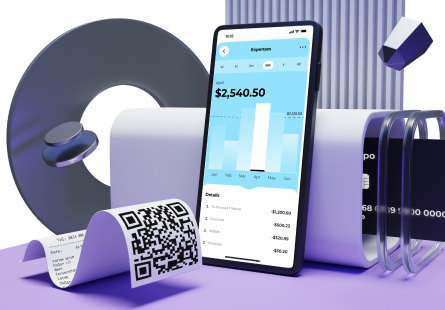In the rapidly evolving landscape of fintech, user experience (UX) design plays a pivotal role in attracting and retaining users. One aspect of UX design that has gained significant importance is microinteractions. These subtle, often overlooked details can make a substantial impact on user engagement, creating a more intuitive and enjoyable experience for individuals interacting with financial platforms.
In this article, we will explore the concept of microinteractions, delve into why they matter in the fintech realm, and provide insights into how designers can leverage them to enhance user interfaces.
What are microinteractions?
Microinteractions are the small, subtle animations, feedback loops, or visual cues that occur within a user interface when a specific action is performed. They are the nuanced details that bridge the gap between the user and the system, providing instant, often subconscious, feedback to users as they navigate through an application. From the slight vibration when a button is pressed to the smooth transition between screens, microinteractions are designed to enhance the overall user experience by making interactions more fluid and engaging.
Examples of microinteractions include:
- The subtle vibration or sound when a button is pressed on a mobile device;
- The smooth transition between different states of an interface element (e.g., a button changing color when hovered over);
- Animated loading indicators that provide visual feedback while content is being fetched;
- Confirmation messages that appear briefly after completing a form or submitting information;
- Interactive elements that respond to user gestures, such as swiping or tapping.
All in all, microinteractions are the fine details that contribute to the overall feel and usability of a digital interface. When implemented effectively, they enhance user engagement, improve usability, and contribute to a more positive and memorable user experience.
Why microinteractions matter
Microinteractions play a crucial role in the world of user experience design, fulfilling a spectrum of purposes that collectively contribute to the overall usability and appeal of digital interfaces. These nuanced design elements are meticulously crafted to engage users on a subtle yet profound level, enhancing their interaction with digital platforms.
Here’s why microinteractions matter:
Feedback: the silent communicator
One primary function of microinteractions is to provide users with immediate feedback, transforming the digital experience from a passive interaction to an engaging conversation. Whether it’s the gentle vibration of a smartphone upon tapping a button or the subtle change in color when hovering over an element, these microfeedback mechanisms silently communicate to users that their actions have been received and are in the process of being executed. This real-time acknowledgment not only reduces uncertainty but also contributes significantly to the overall usability of the system.
Guidance: navigating the digital landscape
In the vast landscape of digital applications, users often find themselves navigating through complex processes. Microinteractions serve as beacons, guiding users seamlessly through workflows by providing visual cues and hints. These subtle signposts help users comprehend their current position within an application, understand available actions, and anticipate what comes next. Particularly crucial in intricate workflows or feature-rich applications, this guidance ensures that users can navigate effortlessly and make the most of the platform’s functionalities.
Delight: crafting memorable experiences
Beyond functionality, microinteractions have the power to evoke positive emotions and create moments of delight. When well-crafted, these small animations or visual effects contribute to a more enjoyable user experience. In the realm of fintech, where transactions and financial management can be inherently serious, adding a touch of delight through microinteractions can humanise the experience, making it not only efficient but also engaging and memorable.
Confirmation: building trust in critical moments
Especially pertinent in applications dealing with sensitive tasks like financial transactions, microinteractions serve as confirmation mechanisms. These subtle affirmations reassure users that their actions have been successfully completed, instilling a sense of trust and confidence in the digital platform. The assurance provided by these microconfirmations is paramount, particularly in scenarios where users require immediate feedback regarding the success or failure of their actions.
Humanising the interaction: bridging the digital divide
By infusing digital interactions with small, human-like touches, microinteractions contribute to humanising the overall user experience. This goes beyond mere functionality, aiming to create a connection between the user and the digital environment. Whether it’s the lifelike animation of a loading screen or the empathetic tone of a confirmation message, these humanising touches foster a sense of familiarity, making users feel more connected and at ease within the digital landscape.
Let’s say, microinteractions are the unsung heroes of user experience design. These small details collectively shape the way users perceive and interact with digital platforms, creating an environment that is not only functional but also enjoyable, trustworthy, and, ultimately, human. As technology continues to advance, the thoughtful integration of microinteractions will remain a key element in designing user experiences that resonate and endure.
How to use microinteractions for fintech UI/UX design
Effectively incorporating microinteractions into fintech UI/UX design requires a deliberate and strategic approach. To achieve this, designers should start by gaining a comprehensive understanding of user flows and identifying critical touchpoints within the application. By focusing on key interactions like fund transfers, account creation, or security verifications, designers can tailor microinteractions to address specific user needs and enhance the overall user journey.
Consistency is paramount in microinteraction design. Maintaining a uniform visual language and feedback mechanisms across the entire platform fosters predictability, reducing the learning curve for users as they navigate different sections of the application. Whether it’s the animation style, sound effects, or feedback duration, a cohesive design language ensures a seamless and harmonious user experience.
While microinteractions contribute to visual appeal, it’s crucial to prioritise performance. These animations and feedback loops should enhance, not impede, the overall user experience. Striking a balance between visual sophistication and functional efficiency is essential, ensuring that microinteractions do not compromise the speed and responsiveness of the application.
Accessibility should be a central consideration in microinteraction design. Designers need to cater to users with disabilities by providing alternative feedback mechanisms, such as descriptive text or audio cues. This inclusive approach ensures that the design is accessible to a diverse user base, promoting an experience that is universally usable.
In conclusion, the thoughtful integration of microinteractions in fintech UI/UX design contributes to a more intuitive, engaging, and inclusive digital experience. By understanding user flows, maintaining consistency, prioritising performance, and embracing accessibility, designers can leverage microinteractions to enhance the overall usability of financial technology applications.
Real-life examples of microinteractions in fintech
Let’s explore some real-life examples of microinteractions in fintech by looking at features implemented by prominent companies in the industry:
Square Cash App – Transaction animation
When users send money using the Square Cash App, they experience a subtle yet satisfying animation. Upon confirming a successful transaction, the app displays a cascading animation of dollar bills, providing a visually appealing and rewarding confirmation of the completed payment. This microinteraction contributes to a positive user experience, making the financial transaction feel seamless and enjoyable.
PayPal – Fingerprint authentication
PayPal employs microinteractions to enhance the security and authentication process. Users can log in using biometric features like fingerprint recognition. The microinteraction occurs when users place their finger on the sensor, and the interface responds with a brief vibration and a visual cue, such as a fingerprint icon changing color. This provides users with immediate feedback, assuring them that the authentication process is underway.
Robinhood – Investment Confirmation
In the Robinhood investment app, microinteractions are used to confirm and celebrate successful stock purchases. After completing a trade, users witness a visually engaging animation, such as a rising stock chart or a confetti shower, accompanied by a subtle sound effect. This microinteraction not only provides confirmation but also adds an element of gamification, making the financial experience more enjoyable.
Chime – Real-time Balance Updates
Chime, an online neobank, employs microinteractions to keep users informed about their account balances in real time. As users navigate through transactions or check their balance, the numbers smoothly transition with subtle animations. This provides users with instant feedback on their financial status, making the interface more dynamic and engaging.
Revolut – Card Payment Confirmation
Revolut, a digital banking platform, utilises microinteractions to confirm card payments. When users make a purchase with their Revolut card, the app displays a brief animation, such as a card swipe or a payment icon, accompanied by a sound effect. This immediate visual and auditory feedback assures users that their transaction has been successfully processed, reinforcing confidence in the platform.
These examples demonstrate how microinteractions are woven into the user experience of leading fintech applications. From transaction animations to security confirmations, these subtle design elements contribute to a more intuitive, enjoyable, and trustworthy interaction with financial platforms. As fintech companies continue to innovate, we can expect to see further advancements in microinteraction design to elevate user engagement and satisfaction.
Conclusion
In the competitive landscape of fintech, where user trust and satisfaction are paramount, microinteractions emerge as a powerful tool for designers to enhance the overall user experience. By incorporating subtle animations, feedback loops, and visual cues, fintech applications can create a more engaging, intuitive, and emotionally resonant interface. As the fintech industry continues to evolve, the thoughtful integration of microinteractions will likely play an increasingly significant role in shaping user interactions and fostering lasting connections between users and their financial tools.







